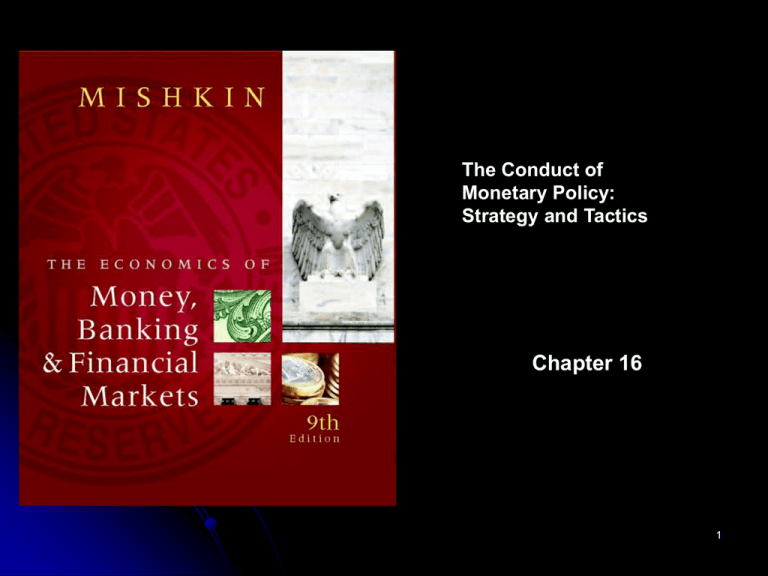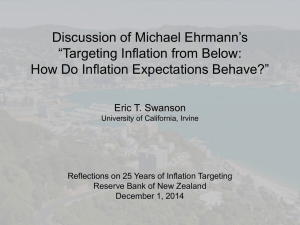Ch16
advertisement

The Conduct of Monetary Policy: Strategy and Tactics Chapter 16 1 Monetary Targeting I United States Fed began to announce publicly targets for money supply growth in 1975. Paul Volcker (1979) focused more on nonborrowed reserves Greenspan announced in July 1993 that the Fed would not use any monetary aggregates as a guide for conducting monetary policy 2 Monetary Targeting II Japan In 1978 the Bank of Japan began to announce “forecasts” for M2 + CDs Bank of Japan’s monetary performance was much better than the Fed’s during 1978-1987. In 1989 the Bank of Japan switched to a tighter monetary policy and was partially blamed for the “lost decade” 3 Monetary Targeting III Germany The Bundesbank focused on “central bank money” in the early 1970s. A monetary targeting regime can restrain inflation in the longer run, even when targets are missed. The reason of the relative success despite missing targets relies on clearly stated monetary policy objectives and central bank engagement in communication with the public. 4 Monetary Targeting Flexible, transparent, accountable Advantages Almost immediate signals help fix inflation expectations and produce less inflation Almost immediate accountability Disadvantages Must be a strong and reliable relationship between the goal variable and the targeted monetary aggregate 5 Inflation Targeting I Public announcement of medium-term numerical target for inflation Institutional commitment to price stability as the primary, long-run goal of monetary policy and a commitment to achieve the inflation goal Information-inclusive approach in which many variables are used in making decisions Increased transparency of the strategy Increased accountability of the central bank 6 Inflation Targeting II New Zealand (effective in 1990) Canada (1991) Inflation was brought down and remained within the target most of the time. Growth has generally been high and unemployment has come down significantly Inflation decreased since then, some costs in term of unemployment United Kingdom (1992) Inflation has been close to its target. Growth has been strong and unemployment has been decreasing. 7 Inflation Targeting III Advantages Does not rely on one variable to achieve target Easily understood Reduces potential of falling in timeinconsistency trap Stresses transparency and accountability Disadvantages Delayed signaling Too much rigidity Potential for increased output fluctuations Low economic growth during disinflation 8 Inflation Targets Source: Ben S. Bernanke, Thomas Laubach, Frederic S. Mishkin, and Adam S. Posen, Inflation Targeting: Lessons from the International Experience (Princeton: Princeton University Press, 1999), updates from the same sources, and www.rbnz.govt.nz/statistics/ econind/a3/ha3.xls 9 Monetary Policy with an Implicit Nominal Anchor There is no explicit nominal anchor in the form of an overriding concern for the Fed. Forward looking behavior and periodic “preemptive strikes” The goal is to prevent inflation from getting started. 10 Monetary Policy with an Implicit Nominal Anchor II Advantages Uses many sources of information Avoids time-inconsistency problem Demonstrated success Disadvantages Lack of transparency and accountability Strong dependence on the preferences, skills, and trustworthiness of individuals in charge Inconsistent with democratic principles 11 Advantages and Disadvantages of Different Monetary Policy Strategies 12 Tactics: Choosing the Policy Instrument Tools Policy instrument (operating instrument) Open market operation Reserve requirements Discount rate Reserve aggregates Interest rates May be linked to an intermediate target Interest-rate and aggregate targets are incompatible (must chose one or the other). 13 Linkages Between Tools, Policy Instruments, Intermediate Targets, and Goals 14 Result of Targeting on Nonborrowed Reserves 15 Criteria for Choosing the Policy Instrument Observability and Measurability Controllability Predictable effect on Goals 16 The Taylor Rule, NAIRU, and the Phillips Curve Federal funds rate target = inflationgap rateand equilibrium realgap fed funds rate An inflation an output 1/2real (inflation (outputconcern gap) Stabilizing output gap) is an1/2 important Output gap is an indicator of future inflation as shown by Phillips curve NAIRU Rate of unemployment at which there is no tendency for inflation to change 17 Result of Targeting on the Federal Funds Rate 18 Central Bank’s Response to Asset Price Bubbles Asset-price bubble: pronounced increase in asset prices that depart from fundamental values, which eventually burst. Types of asset-price bubbles Credit-driven bubbles Subprime financial crisis Bubbles driven solely by irrational exuberance 19 Lessons From the Subprime Crisis Should central banks respond to bubbles? Strong argument for not responding to bubbles driven by irrational exuberance Bubbles are easier to identify when asset prices and credit are increasing rapidly at the same time. Monetary policy should not be used to prick bubbles. 20 Lessons From the Subprime Crisis Macropudential regulation: regulatory policy to affect what is happening in credit markets in the aggregate. Central banks and other regulators should not have a laissez-faire attitude and let credit-driven bubbles proceed without any reaction. 21 Historical Perspective I Discount policy and the real bills doctrine Discovery of open market operations The Great Depression Reserve requirements as a policy tool Thomas Amendment to the Agricultural Adjustment Act of 1933 War finance and the pegging of interest rates 22 Historical Perspective II Targeting money market conditions Procyclical monetary policy Targeting monetary aggregates New Fed operating procedures De-emphasis of monetary aggregates De-emphasis of federal funds rate Borrowed reserves target Federal funds targeting again Greater transparency 23 Historical Perspective III Preemptive strikes against inflation Preemptive strikes against economic downturns and financial disruptions LTCM Enron Subprime meltdown International policy coordination 24 The Taylor Rule for the Federal Funds Rate Source: Federal Reserve: www.federalreserve.gov/releases and author’s calculations. 25 http://research.stlouisfed.org/publications/mt/page10.pdf 26











